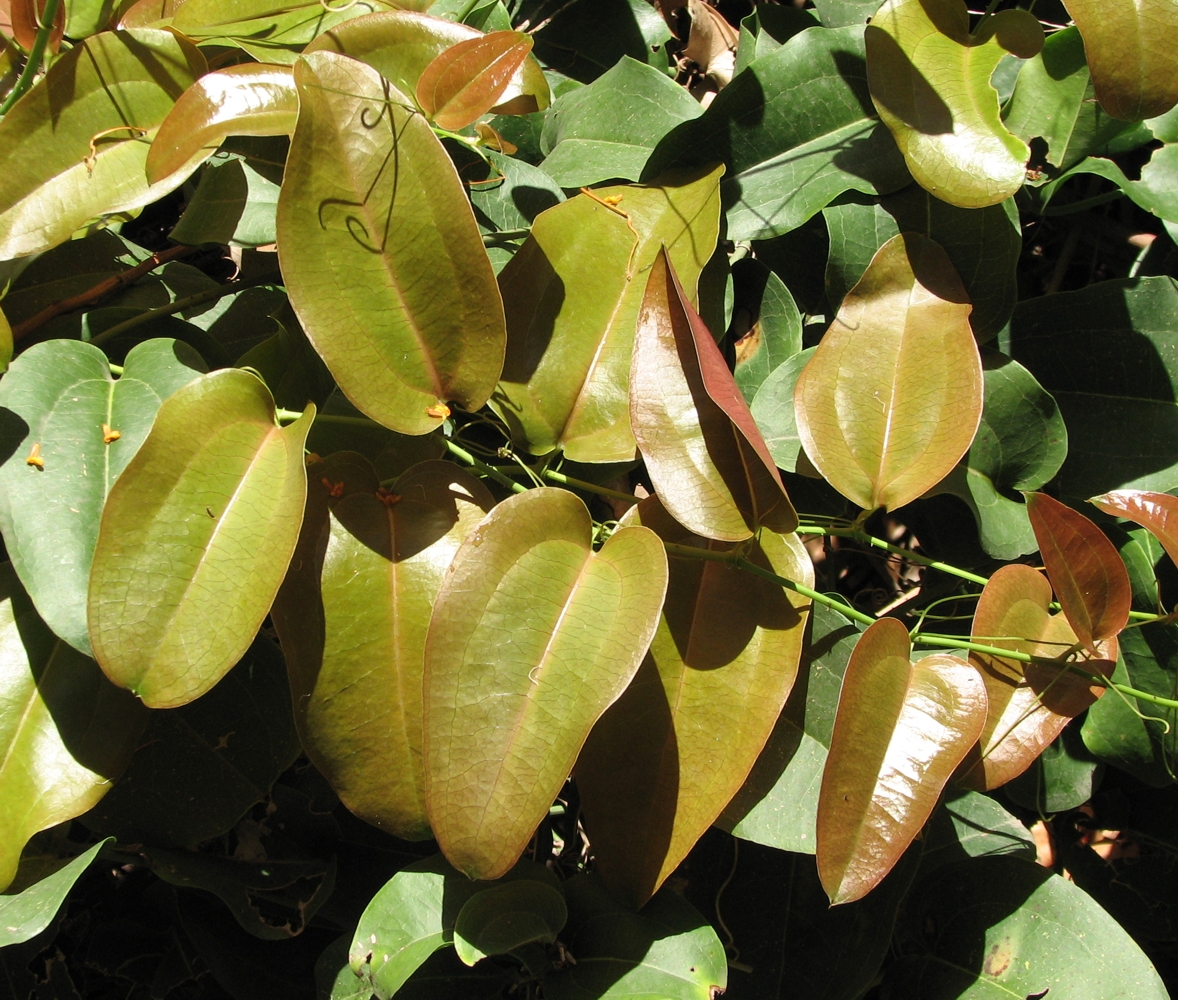Exploring Wombat Berry, Bush Banana
Scientifically recognized as Smilax australis and classified under Family: Smilacaceae, Order: Liliales, stands out as a distinctive Perennial vine known for its unique characteristics. While it may also be found under other Synonyms, Smilax racemosa, S. atrovirens.withN/A form. You can use our free plant care app PlantPlants to identify Wombat Berry, Bush Banana.
Temperature
Minimum 5 C (41 F), Maximum 35 C (95 F)
Watering
Regular watering, while avoiding waterlogged soils
Fertilizing
Balanced organic fertilizer
Sunlight
Partial shade to full shade
Toxicity
Generally safe when ripe; unripe berries may be toxic



Appearance and Growth Of Wombat Berry, Bush Banana
At maturity, this species reaches approximately Up to 3 meters (9.8 feet) long, presenting Heart-shaped, glossy, dark green leaves along with Clusters of small, greenish-yellow flowers in spring, followed by Edible, berry-like drupes that turn blackish when ripe. These features are supported by a reliable Thick, fibrous roots, ensuring stability and sustained growth.
Wombat Berry, Bush Banana Origin and Habitat
Native to Australia and surrounding regions, Wombat Berry, Bush Banana thrives in Moist, shaded forests and woodlands at elevations around Sea level to about 1,200 meters (3,937 feet). Best suited for USDA Hardiness Zone 9-11. Whether grown indoor, in a curated garden or a more natural setting, its ecological requirements help maintain its vigor over time.



How to take Care of Wombat Berry, Bush Banana
Light, Soil and Watering Wombat Berry, Bush Banana.
You can use our free plant identify app PlantPlants to chose the best spot for Wombat Berry, Bush Banana, This plant prefers Partial shade to full shade and flourishes in Well-drained, organic-rich soils with a soil pH of about 5.5 7.0.
Wombat Berry, Bush Banana needs watering,Regular watering, while avoiding waterlogged soils, guided by PlantPlants app, You can get plants daily watering schedule. to maintain Moist to slightly dry, ensure steady hydration. Applying water through Soaking method to thoroughly wet the soil supports even distribution and helps prevent overwatering or dryness.
Temperature and Humidity
Wombat Berry, Bush Banana performs best within 15 C to 30 C (59 F to 86 F). Its ideal growth occurs at around 20 C to 25 C (68 F to 77 F), though it tolerates ranges from Minimum 5 C (41 F), Maximum 35 C (95 F). Additionally, maintaining Moderate to high humidity encourages healthy foliage and overall plant vigor.
Fertilization & Soil Health
Feeding with Balanced organic fertilizer at the recommended Seasonal Application Frequency on PlantPlants App keeps nutrients balanced. Incorporating Compost or leaf mold enhances soil structure and fertility, while staying alert to Yellowing leaves and stunted growth helps you adjust care as needed to maintain optimal plant health.
Routine and Maintenance
Regular attention ensures this plant’s beauty and longevity. Late winter to early spring for Light pruning to control growth tidies its appearance, while Every 2-3 years may be necessary as it grows, requiring a 1-2 size increments when repotting increase and a fresh Standard potting soil with perlite. for Staking or Support. Requires support for climbing.
Seasonal Changes and Propagation of Wombat Berry, Bush Banana
During Winter months, growth may slow and some Evergreen; leaves remain throughout the year can occur. For those looking to propagate, consider Seed, division, stem cuttings and provide Warm temperatures and consistent moisture when starting from seed. If using cuttings, follow Use semi-hardwood cuttings with humidity control to ensure successful rooting and healthy new plants.
Pests, Diseases and Prevention
our free plant identify and care app PlantPlants can help you diagnosisWombat Berry, Bush Banana problems.Though generally robust, keep watch for Aphids, spider mites and remain vigilant against Root rot in waterlogged conditions. Implementing Maintain good airflow and soil drainage and applying Insecticidal soap or neem oil for pests; improve drainage for diseases when issues arise will help sustain the plant thriving.
Companions and Uses of Wombat Berry, Bush Banana
This plant pairs nicely with Other native Australian plants and shows N/A, making it a flexible choice for various Ground cover, erosion control, shade gardens.
Edible and Cultural Aspects
the Edible Parts: Ripe berries, young shoots. Toxicty of Wombat Berry, Bush Banana, Generally safe when ripe; unripe berries may be toxic. learning about its Late summer; berries can be picked by hand, Can be eaten raw, added to jams, or used in desserts, and Rich in carbohydrates and vitamins can be intriguing for culinary explorers. Some traditions highlight its Traditionally used by Indigenous Australians for various ailments or note its An important food source for local fauna and indigenous peoples.
Conservation and Status
With an Least Concern, proper Habitat protection and sustainable foraging practices.
Frequently Asked Questions
1. Is the wombat berry edible?
Yes, the ripe berries are edible and can be consumed fresh or used in cooking.
2. Where does the wombat berry grow?
It is native to Australia, commonly found in moist, shaded forest areas.
3. What type of soil does the wombat berry prefer?
It prefers well-drained, organic-rich soils with a slightly acidic to neutral pH.
4. How do I propagate wombat berry?
It can be propagated from seeds, division, or stem cuttings in warm, moist conditions.
5. What pests affect the wombat berry?
Common pests include aphids and spider mites, which can be managed with insecticidal soap.
6. Does the wombat berry require a lot of water?
It needs regular watering, especially in dry spells, but avoid waterlogging.
7. When should I prune my wombat berry?
Prune in late winter to early spring to control growth and shape.
8. What is the ideal temperature for wombat berry growth?
The ideal growth temperature is between 20 C to 25 C (68 F to 77 F).
9. Are wombat berries used in traditional medicine?
Yes, they have been used traditionally by Indigenous Australians for various medicinal purposes.
10. How can I use wombat berries in cooking?
They can be eaten raw, added to jams, or incorporated into desserts.



